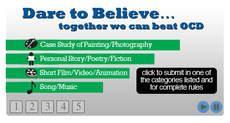
Half a million teens in the US suffer from OCD
But stories engage us at multiple levels and using all of our senses and, most importantly, they create a shared space of understanding. This opens a pathway to our right brain, activating our creativity and imagination; we can experience stepping out of our own world and into another. For a sufferer of OCD, stories can show proof of hope and help suffers image possibilities for the future and change their mindset to one of success. For others, stories will raise awareness and compassion for sufferers of OCD.

OCD Foundation campaign: “Dare to Believe”
Technology provides a multitude of platforms for storytelling. The most powerful engage multiple media — or transmedia — to build a broader, richer story experience. The International OCD Foundation’s new campaign, Dare to Believe, and contest in celebration of OCD Awareness Week, Oct. 10-16. is an opportunity for you to learn, inspire, and be inspired through transmedia storytelling. In order to share the experience of OCD sufferers with others and to inspire them that treatment is possible, Dave to Believe is asking OCD sufferers to submit their stories in art, video, music, poetry, or short stories. (Deadline for submissions is August 31.) Each individual story is part of a larger narrative of struggle, difficulties, hard work, success, and hope.
The OCD Foundation will select the best representatives of the Dare to Believe themes of “treatment works” and “there is hope.” Winners will win a free trip to the Boston even on October 15 and stories will be streamed on the Internet.
For more information about Obsessive Compulsive Disorder (OCD) or the Dare to Believe campaign, see the OCD Foundation website www.ocfoundation.org. The site also has interactive information for finding local support groups and learning more about what it’s like to live with obsessive-compulsive behaviors like counting, checking, and hoarding.

